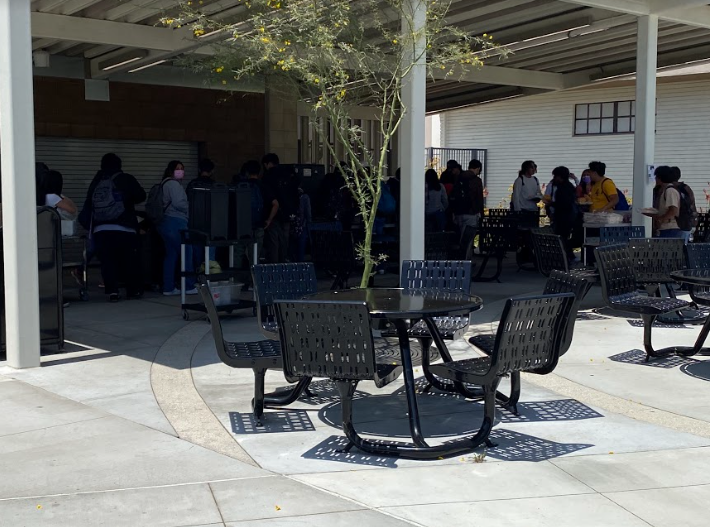With the free meal waiver coming to an end, SAUSD rises to the occasion to handle this matter
Students get their free nutritious lunch provided by the MCHS cafeteria.
As the waiver for free nutritious meals comes to an end this upcoming summer, schools and parents are struggling to find an alternate means of feeding children.
When virtual learning first hit schools and parents got laid off from their jobs due to the pandemic, it got difficult for parents to be able to provide a nutritious meal to their children. In response to this, a waiver was signed to enable schools and other child care services to provide free, safe, and nutritious meals to those who need it. This waiver was set effective from July 1, 2021 through June 30, 2022. As we are entering a time where things might be going back to normal, the waiver is coming to an abrupt end and leaves many families wondering what their next move is on this matter.
Getting meals throughout school days is no problem as California became the first state to implement a statewide Universal Meals Program where students are provided with free breakfast and lunch. The issue arises when school is no longer in session such as winter break or summer vacation. Millions of students and parents heavily rely on the waiver to be able to help them with the backlash of the pandemic.
A 5th grade student at USC College Prep shares their experience on how free meals during the pandemic saved their family.
“Both my parents were laid off from their jobs and it made things really hard on them. Despite being told to stay in and only to go out to buy food, they had trouble trying to put food on the table. When I heard many schools were offering free lunches it saved my parents since they would have to go out and expose themselves in order to earn money,” they said.
With current high prices in gas and inflation, it is harder for schools to be able to purchase what they need to provide students with a nutritious meal.
SAUSD Director of Nutrition Service, Josh Goddard, shares his thoughts on this matter.
“We take food access very seriously, and we know that for many students the meals we serve at school may be all they get for some length of time. With this in mind, we continue to look for every opportunity possible to maximize our meal services options. Though the expiration of these federal waivers will not prevent us from serving meals, it will significantly reduce the flexibility with which we have served children over the last two years. For example, we have heard from countless parents and guardians that the meals pick-up option, allowing for children and virtual learners to enjoy a meal at home, has been immensely helpful as families balance nutrition needs with impacted work schedules. The higher reimbursement rates (which are still just barely over four dollars per lunch) are being reduced to their normal “acceptable” level. With food and supply costs increasing at worrying rates, a stagnant and structurally low rate of reimbursement will impede the District’s plans to offer consistent menu choices. With these and many other waivers coming to an end, it will put pressure on SAUSD’s Nutrition Services team – our central objective is to ensure the student does not suffer because of it,” he said.
School officials have been asking the federal government to extend waivers that would make it easier for more meals to be pushed out to students. The waivers not only made it easier to acquire free lunches for everyone but also made it easier for kids to get meals during the summer. The U.S. Department of Agriculture granted waivers because of the pandemic that come with many benefits to help out students. One of these benefits includes summer meal programs, which makes life significantly easier for parents. They are able to bring breakfast and lunches home to their children. Without this waiver, students would have to eat those meals on site. At the moment none of these waivers has been officially approved by Congress.
Goddard responded to this by saying, “The ball is in the Congress’s court. They have the power to ensure students receive adequate nutrition during this tumultuous period and beyond. I sincerely hope those with the power to help those that need it rise to the occasion. Irrespective of what happens federally, we will continue to do everything we can to guarantee nutritional needs are met and that meal offerings continue to improve in SAUSD. We have some exciting initiatives in the works: sourcing local produce directly from growers, scratch cooking across all District menus (we are investing more than two million dollars towards upgrading our cooking equipment), a plug-in electric food truck is being built to promote the benefits of eating local plant-based foods and show how SAUSD is doing its part to serve climate-friendly foods, a new central kitchen is being designed (we are getting the ball rolling on building a funding source for the construction project), and much more information that we will be sharing in our upcoming newsletter.”
The hardship of the pandemic even affected students mentally. Being in a situation where food would be hard to come by and trying to focus on school is difficult; it can be mentally challenging as one has the need to try and help their parents as much as possible during times of hardship.
Another 5th grader at College Prep shares how they felt.
They said, “When the pandemic hit hard I deeply relied on the school lunches provided by the school. I always found it kind of embarrassing having to go to them because I am not from a financially stable family and I have friends who are. It sometimes makes me feel less of a person even though it is not entirely in my control. Despite that, it was still extremely helpful to have many free meal programs that allowed me to focus on school rather than what I was going to eat next.”
The student’s parent adds onto this by stating, “We have had our fair share of hardships and it was not something that we could easily come out of. It definitely took a toll on me, my wife, and my kids as they sometimes would not go with me to pick up food out of sheer embarrassment. I never held them responsible for it because it was far from our control. I am just glad that things are so much better than they were before and I hope others realize that there is no shame in receiving help.”
With summer quickly approaching, many are left wondering what will happen once the waivers are expired. Goddard explains the next course of action that SAUSD will take once the waivers are done.
“SAUSD serves school meals to its students under the Community Eligibility Provision (CEP). This program allows the District to serve a breakfast and lunch to all students – regardless of household income – at no cost. We also serve suppers to students attending after school programs. We will be serving breakfast and lunch to all children ages 1 to 18 at nearly 60 sites this summer! The list is still being finalized, and the dates the program will run are approximately from June 6th through July 29th (Monday to Friday). All of the details for our summer meal services will be shared on SAUSD’s website, social media, local press releases, email subscription lists, and all-call messaging to parents.”
Although the end to waivers is on its way there is an alternative plan to help those who continue to struggle purchasing meals. More information regarding future plans will be shared as school comes to a gradual end.






































